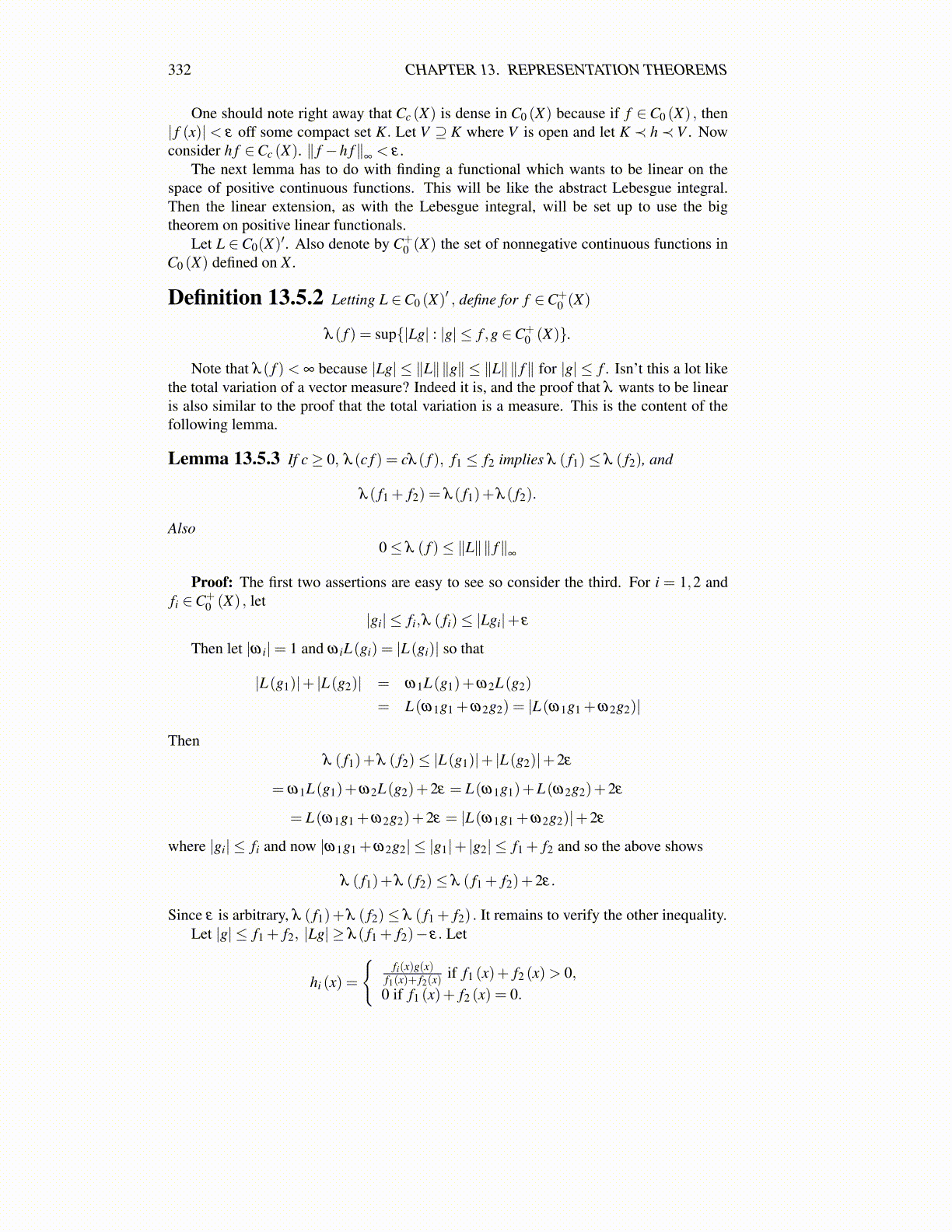
332 CHAPTER 13. REPRESENTATION THEOREMS
One should note right away that Cc (X) is dense in C0 (X) because if f ∈C0 (X) , then| f (x)| < ε off some compact set K. Let V ⊇ K where V is open and let K ≺ h ≺ V . Nowconsider h f ∈Cc (X). ∥ f −h f∥
∞< ε .
The next lemma has to do with finding a functional which wants to be linear on thespace of positive continuous functions. This will be like the abstract Lebesgue integral.Then the linear extension, as with the Lebesgue integral, will be set up to use the bigtheorem on positive linear functionals.
Let L ∈C0(X)′. Also denote by C+0 (X) the set of nonnegative continuous functions in
C0 (X) defined on X .
Definition 13.5.2 Letting L ∈C0 (X)′ , define for f ∈C+0 (X)
λ ( f ) = sup{|Lg| : |g| ≤ f ,g ∈C+0 (X)}.
Note that λ ( f )< ∞ because |Lg| ≤ ∥L∥∥g∥ ≤ ∥L∥∥ f∥ for |g| ≤ f . Isn’t this a lot likethe total variation of a vector measure? Indeed it is, and the proof that λ wants to be linearis also similar to the proof that the total variation is a measure. This is the content of thefollowing lemma.
Lemma 13.5.3 If c≥ 0, λ (c f ) = cλ ( f ), f1 ≤ f2 implies λ ( f1)≤ λ ( f2), and
λ ( f1 + f2) = λ ( f1)+λ ( f2).
Also0≤ λ ( f )≤ ∥L∥∥ f∥
∞
Proof: The first two assertions are easy to see so consider the third. For i = 1,2 andfi ∈C+
0 (X) , let|gi| ≤ fi,λ ( fi)≤ |Lgi|+ ε
Then let |ω i|= 1 and ω iL(gi) = |L(gi)| so that
|L(g1)|+ |L(g2)| = ω1L(g1)+ω2L(g2)
= L(ω1g1 +ω2g2) = |L(ω1g1 +ω2g2)|
Thenλ ( f1)+λ ( f2)≤ |L(g1)|+ |L(g2)|+2ε
= ω1L(g1)+ω2L(g2)+2ε = L(ω1g1)+L(ω2g2)+2ε
= L(ω1g1 +ω2g2)+2ε = |L(ω1g1 +ω2g2)|+2ε
where |gi| ≤ fi and now |ω1g1 +ω2g2| ≤ |g1|+ |g2| ≤ f1 + f2 and so the above shows
λ ( f1)+λ ( f2)≤ λ ( f1 + f2)+2ε.
Since ε is arbitrary, λ ( f1)+λ ( f2)≤ λ ( f1 + f2) . It remains to verify the other inequality.Let |g| ≤ f1 + f2, |Lg| ≥ λ ( f1 + f2)− ε. Let
hi (x) =
{fi(x)g(x)
f1(x)+ f2(x)if f1 (x)+ f2 (x)> 0,
0 if f1 (x)+ f2 (x) = 0.